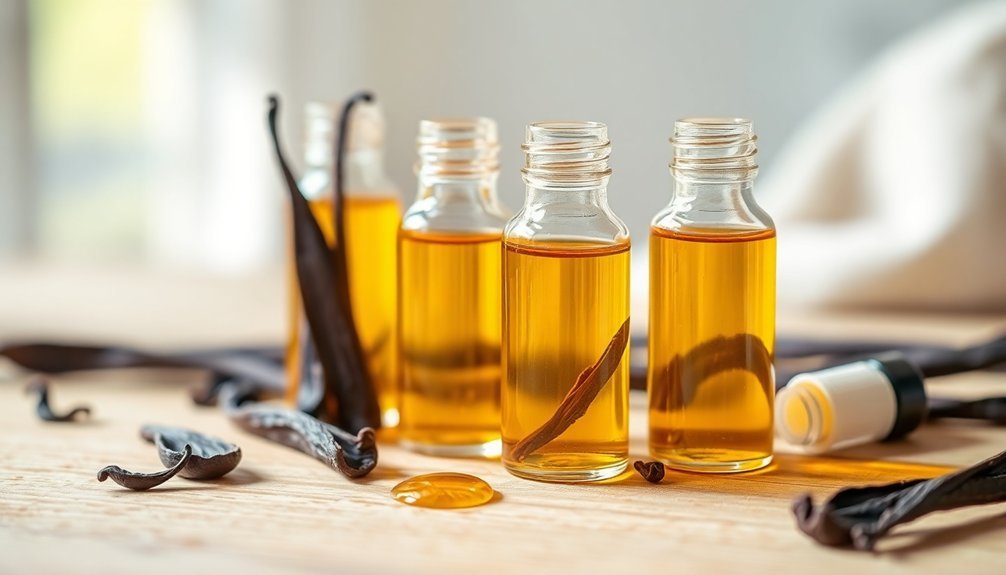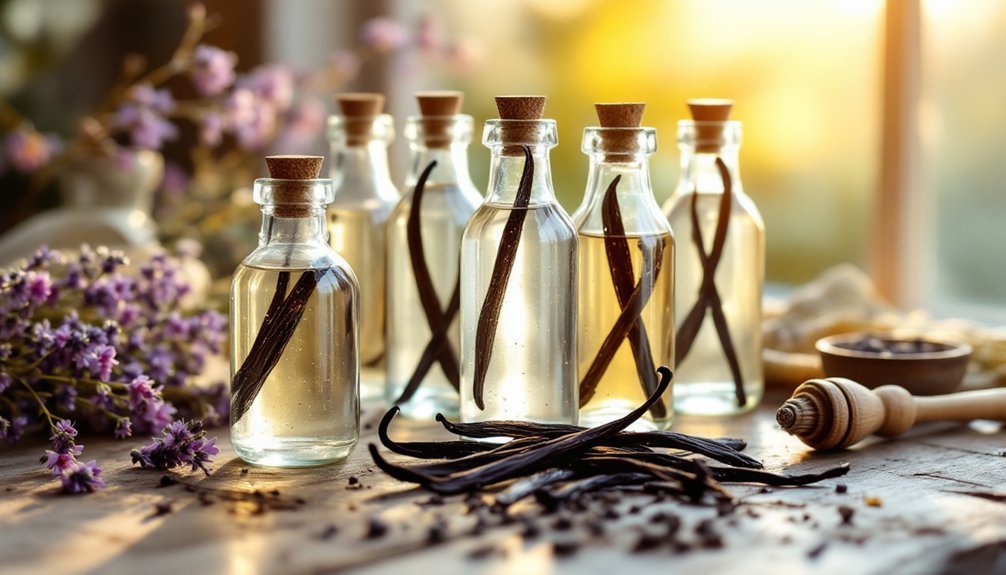You can easily create your own natural vanilla perfume without alcohol using two simple methods. For a glycerin-based version, infuse split vanilla beans in vegetable glycerin for two weeks, then strain and bottle. Alternatively, blend vanilla beans or essential oil with carrier oils like jojoba or sweet almond oil. Both recipes offer pure, long-lasting scents that won't irritate sensitive skin. Discover how to enhance and preserve your signature vanilla fragrance below.
Why Choose Alcohol-Free Vanilla Perfumes

While traditional perfumes often rely on alcohol as a base, alcohol-free vanilla perfumes offer compelling benefits for both your skin and the environment.
You'll notice your skin stays more hydrated and naturally moisturized since these perfumes don't strip away essential oils. If you have sensitive skin, you'll appreciate how they minimize irritation and protect your skin's natural barrier. A small dab of these perfumes on your pulse points delivers hours of fragrance.
The eco-conscious choice of alcohol-free perfumes aligns with sustainable beauty practices. You're reducing your environmental impact through minimal packaging and fewer chemical ingredients.
Plus, you'll experience a purer, longer-lasting vanilla fragrance that unfolds naturally on your skin. Whether you're avoiding alcohol for personal reasons or seeking a gentler alternative, these perfumes offer versatility in use and can be customized to your preferences.
Essential Ingredients for Natural Vanilla Fragrances
You'll find several effective vanilla bean extract options, from pure vanilla absolute to Madagascar vanilla oleoresin, each offering unique characteristics for your natural perfume.
When selecting your base oils, consider jojoba or sweet almond oil as primary carriers, as they're particularly compatible with vanilla notes and offer excellent stability.
To enhance your vanilla fragrance naturally, you can incorporate scent-boosting ingredients like tonka bean absolute, benzoin, or sandalwood that add depth and longevity to your creation. Since vanilla absolute alone lacks staying power, incorporating balanced essential oils helps create a more enduring fragrance.
Vanilla Bean Extract Options
Creating a natural vanilla fragrance starts with selecting the right vanilla beans for extraction.
You'll find three main varieties to choose from: Madagascar beans offer a smooth, creamy scent perfect for traditional vanilla fragrances, while Tahitian beans provide a more floral, fruity aroma that's especially suited for perfumes. Mexican beans deliver a deep, rich scent that adds complexity to your creation.
For alcohol-free extraction, you'll want to use vegetable glycerin as your base. Dark glass bottles help preserve the extract's quality during the infusion process.
Mix it with water in a 3:1 ratio to prevent spoilage. While this method requires more patience – typically 5 to 6 months for full infusion – it creates a stable, syrupy extract that's ideal for perfumes.
Remember that high-quality beans are essential for achieving a potent, authentic vanilla fragrance.
Base Oil Compatibility Guide
Selecting the right carrier oil forms the foundation of any successful alcohol-free vanilla perfume. For your vanilla creation, you'll want to take into account both your skin type and fragrance goals.
If you have dry skin, reach for jojoba or apricot kernel oil, as they'll provide extra nourishment while carrying your vanilla scent. Those with oily skin should opt for lightweight grapeseed oil, which won't leave a greasy residue.
For the longest-lasting vanilla fragrance, jojoba oil is your best choice, as it closely mimics your skin's natural oils and helps lock in scents.
You'll want to start with 15-30 drops of vanilla extract per ounce of carrier oil, adjusting the ratio to match your preferred intensity. Remember, you can always blend different carrier oils to create a personalized base that suits your skin's needs.
Scent-Boosting Natural Ingredients
While vanilla provides a beautiful foundation for natural perfumes, combining it with complementary essential oils can transform your fragrance into a sophisticated blend.
You'll find that lavender adds a calming element, while bergamot introduces an uplifting citrus note to brighten the mix. For depth and warmth, consider adding sandalwood or patchouli, which create rich, earthy undertones.
To enhance the vanilla's natural sweetness, you can incorporate benzoin resin or a touch of ho wood. These ingredients work together to create complex layers in your perfume while maintaining the comforting qualities of vanilla.
When selecting your combinations, remember that natural ingredients offer more than just fragrance – they provide skin-nourishing benefits and are less likely to cause irritation than synthetic alternatives.
Glycerin-Based Vanilla Perfume Recipe
Making your own glycerin-based vanilla perfume offers a safe and effective alternative to traditional alcohol-based fragrances.
You'll need vegetable glycerin as your base, vanilla beans or essential oil for the primary scent, and optional complementary essential oils like lavender or jasmine.
Start by splitting open your vanilla beans and infusing them in glycerin. If you'd like a lighter consistency, you can add a small amount of distilled water.
Let your mixture mature in a dark place for at least two weeks to develop a rich fragrance. During this time, you can adjust the scent by adding other essential oils.
Once matured, strain the mixture and store it in a dark glass bottle to preserve the fragrance. The high glycerin concentration will help maintain your perfume's quality and prevent spoilage.
Carrier Oil Vanilla Blend Recipe

Start by selecting your preferred carrier oil from jojoba, sweet almond, or fractionated coconut oil, as each offers unique benefits for your vanilla perfume base.
You'll want to blend your chosen vanilla source (beans, extract, or essential oil) with the carrier oil using a ratio of 2-4 vanilla beans per cup of oil, adjusting the amount based on your desired fragrance intensity.
Keep your finished blend in a dark glass bottle, stored in a cool place away from direct sunlight to maintain its aromatic properties.
Choosing Your Base Oils
The perfect carrier oil forms the foundation of any alcohol-free vanilla perfume, serving as both a delivery system and scent stabilizer.
When crafting your vanilla blend, you'll want to take into account both jojoba and fractionated coconut oil for their exceptional stability and scent-enhancing properties.
For sensitive skin, sweet almond oil's gentle nature makes it an ideal choice, while grapeseed oil's quick absorption and neutral scent work perfectly for daily wear.
If you're looking to add moisturizing benefits to your perfume, contemplate avocado oil's rich properties.
Match your base oil to your specific needs: choose grapeseed for a light, everyday perfume, jojoba for long-lasting wear, or fractionated coconut oil for a non-greasy finish.
Mix Perfect Ratios
When crafting your vanilla perfume blend, proper ratios between carrier oils and essential oils will determine your fragrance's strength and longevity.
Start with a base of 1 ounce of carrier oil – fractionated coconut oil works wonderfully for its lightweight feel and neutral scent. Add 15-30 drops of vanilla essential oil, depending on your desired intensity.
For a more complex scent, you'll want to incorporate complementary oils like jasmine or lavender. Mix in 5-8 drops of these supporting fragrances to create depth.
Remember to start with smaller amounts and adjust as needed. Once you've combined your oils, transfer the mixture to a dark glass bottle and let it mature for two weeks. This resting period allows the fragrances to blend and develop their full potential.
Store For Maximum Freshness
Proper storage of your vanilla perfume blend determines its longevity and fragrance quality. Keep your blend in dark amber glass bottles with airtight lids to protect it from UV light and oxidation.
Store your perfume in a cool spot where temperatures stay between 59°F to 77°F, away from direct sunlight and heat sources.
If you're using carrier oils like jojoba, almond, or fractionated coconut oil in your blend, check regularly for signs of rancidity.
Label your bottles with the preparation date and transfer larger batches to smaller containers if you won't use them quickly.
Wipe any spills with a clean, dry cloth and guarantee caps are tightly sealed after each use.
These simple storage practices will help maintain your vanilla perfume's fresh scent and extend its shelf life.
Tips for Creating Long-Lasting Vanilla Scents

Creating long-lasting vanilla scents requires a thoughtful combination of quality ingredients and proven application techniques.
A successful vanilla fragrance demands careful ingredient selection and proper methods to achieve enduring scent profiles.
You'll achieve the best results by allowing your vanilla mixture to infuse with carrier oils for at least a week, then adding natural fixatives like orris root or tonka bean to extend the fragrance's longevity.
- Apply your perfume after showering and moisturizing, as damp skin better absorbs and holds the scent.
- Focus on pulse points but don't rub them together, as friction can break down the fragrance molecules.
- Consider applying the scent to your clothes or hair, where fibers naturally retain the fragrance longer.
For extra staying power, try blending your vanilla with complementary notes like musk or citrus, and let your final creation mature for a week before regular use.
Storing and Preserving Your Vanilla Perfume
The care you take in storing your homemade vanilla perfume directly impacts its longevity and fragrance quality.
Keep your creation in a dark glass bottle, tightly sealed, and store it in a cool, dry place away from direct sunlight and heat sources. The ideal temperature range is between 60°F and 68°F.
You'll want to maintain consistent humidity levels between 60-80% to preserve your perfume's quality.
Regularly check for any signs of degradation, such as changes in color, consistency, or fragrance intensity. If you notice the scent weakening, you might need to adjust your storage conditions.
Don't forget to let your perfume mature for at least a week before use, as this helps develop a more complex aroma.
Always keep your containers airtight to prevent oxidation and contamination.
Frequently Asked Questions
Can I Use Imitation Vanilla Extract Instead of Pure Vanilla Extract?
You can use imitation vanilla extract, but you'll get a less complex and authentic fragrance. While it's cheaper, it won't provide the same depth and longevity as pure vanilla extract in your perfume.
How Do I Remove Vanilla Perfume Stains From Clothing?
You'll want to blot the stain with cold water, then mix equal parts vinegar and water to treat it. Apply baking soda paste, let it sit, and wash normally. Avoid heat until it's gone.
Why Does My Vanilla Perfume Smell Different on Different People?
Your vanilla perfume smells different on others because everyone's skin pH, oil levels, and body chemistry are unique. Your diet, hormones, and even medications can alter how fragrances interact with your skin.
Are Alcohol-Free Vanilla Perfumes Safe During Pregnancy?
You'll find alcohol-free vanilla perfumes are generally safe during pregnancy, especially if they're made with natural ingredients. However, you should always check ingredients for phthalates and test for personal sensitivities first.
Can I Layer Vanilla Perfume With Other Commercial Fragrances?
Yes, you can layer vanilla perfume with commercial fragrances. Start with a light application and test combinations on your skin first. It works especially well with floral, fruity, woody, or spicy scents.





Leave a Reply